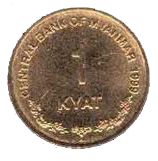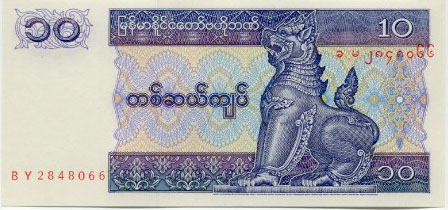|


The kyat (Burmese: ကျပ်, pronounced [tɕaʔ]; ISO 4217 code MMK) is the currency of Myanmar/Burma. It is often abbreviated as "K", which is placed before the numerical value.
History
First kyat, -1889
The kyat was a denomination of both silver and gold coinages in Burma until 1889. It was divided into 20 pe, each of 4 pya, with the mu and mat worth 2 and 4 pe, respectively. Nominally, 16 silver kyat equal 1 gold kyat. The silver kyat was equivalent to the Indian rupee, which replaced the kyat after Burma was conquered by the British.
Second kyat, 1943-1945
When the Japanese occupied Burma in 1942, they introduced a currency based on the rupee. This was replaced at par by the kyat in 1943. This kyat was subdivided into 100 cents. The kyat became worthless at the end of the war when the rupee was reintroduced.
Third kyat, 1952-
The present kyat was introduced on 1 July 1952. It replaced the rupee at par. Decimalization also took place, with the kyat subdivided into 100 pya.
Coins
First kyat
In 1852, Mindon, the second last king of Burma, established the Royal Mint in Mandalay (Central Burma). The dies were made in Paris. Silver coins were minted in denominations of 1 pe, 1 mu (2 pe), 1 mat (4 pe), 5 mu (10 pe) and 1 kyat, with gold 1 pe and 1 mu. The obverses bore the Royal Peacock Seal, from which the coins got their name. The reverse contained the denomination and mint date (in the Burmese era, which starts from A.D. 638). In the 1860s and 1870s, lead coins were issued for ⅛ and ¼ pya, with copper, brass, tin and iron ¼ pe (1 pya) and copper 2 pya. Further gold goins were issued in 1866 for 1 pe, 2½ mu and 1 kyat, with 5 mu issued in 1878.
Second kyat
No coins were issued for this currency.
Third kyat
In 1952, coins were introduced for 1, 5, 10, 25 and 50 pyas and 1 kyat. 1 pya coins were last minted in 1966, with the 5 and 25 pya last minted in 1987 and the 10 and 50 pya in 1991. In 1999, a new series of coins was issued in denominations of 1, 5, 10, 50 and 100 kyats.
In late 2008, the Burmese government announced that new 50 and 100 Kyat coins would be issued. According to newspaper articles, the new 50 kyat coin would be made of copper, with the usual Burmese lion on the observe and the Lotus Fountain from Naypyidaw on the reverse. The 100 Kyat coin would be of cupro-nickel and depict the Burmese lion on the observe and the value on the reverse.
Banknotes
First kyat
No paper money was issued for this currency.
Second kyat
The Burma State Bank issued notes for 1, 5, 10 and 100 kyat in 1944, followed by a further issue of 100 kyat notes in 1945.
Third kyat
In 1953, the Union Bank of Burma introduced the first kyat notes, in denominations of 1, 5, 10 and 100 kyats. These were very similar in design to the last series of rupee notes, issued earlier the same year. In 1958, 20 and 50 kyats notes were introduced. The 50 and 100 kyat notes were demonetized on May 15, 1964. This was the first of several demonetizations, ostensibly carried out with the aim of fighting black marketeering. The Peoples Bank of Burma took over note production in 1965 with an issue of 1, 5, 10 and 20 kyat notes.
In 1972, the Union of Burma Bank took over note issuance, with notes introduced between 1972 and 1979 for 1, 5, 10, 25, 50 and 100 kyats. The notes were printed by the Security Printing Works in Wazi, Upper Burma (established circa 1972) under the technical direction of the German firm Giesecke & Devrient. On November 3, 1985, the 25-, 50-, and 100-kyat notes were demonetized without warning, though the public was allowed to exchange limited amounts of the old notes for new ones. All other denominations then in circulation remained legal tender. On November 10, 1985, 75-kyat notes were introduced, the odd denomination possibly chosen because of dictator Ne Win's predilection for numerology; the 75-kyat note was supposedly introduced to commemorate his 75th birthday. It was followed by the introduction of 15- and 35-kyat notes on August 1, 1986.
Only two years later, on September 5, 1987, the government demonetized the 25-, 35-, and 75-kyat notes without warning or compensation, rendering some 75% of the country's currency worthless. The resulting economic disturbances led to serious riots (see 8888 Uprising) and eventually a coup d'état in 1988 by General Saw Maung. On September 22, 1987, banknotes for 45 and 90 kyat were introduced, both of which incorporated Ne Win's favorite number, nine.
Following the change of the country's name to Myanmar on June 20, 1989, new notes began to be issued. This time, the old notes were not demonetized, but simply allowed to fall into disuse through inflation as well as wear and tear. On March 1, 1990, 1-kyat notes were issued, followed by 200-kyat notes on March 27, 1990. On March 27, 1994, notes for 50 pya, 20, 50, 100, and 500 kyats were issued, followed, on May 1, 1995, by new 5- and 10-kyat notes. 1,000-kyat notes were introduced in November 1998.
In 2003, rumours of another pending demonetization swept through the country, resulting in the junta issuing official denials, but this time the demonetization did not materialize. In 2004, the sizes of the 200, 500, and 1,000 kyats were reduced in size (to make all Myanma banknotes uniform in size) but larger notes remain in circulation. 50 pya, 1, and 5 kyat banknotes are now rarely seen, because of their low value.
On October 1, 2009, banknotes were released with a value of 5000 kyats and it is 15cm by 7cm. On the top is written Central Bank of Myanmar in Burmese and in the center is white elephant. On the back is a picture of the Central Bank of Myanmar with "5000 kyat" written English. This new release of notes, has a significantly higher value than the next highest value banknotes currently in circulation, being 1000 kyats. Public response has been mixed, with some welcoming a higher value bill reducing the number of banknotes which need to be carried. Other responses have suggested a widespread fear that this will simply fuel the current rate of inflation, which was supported by a jump in the blackmarket exchange rates following the public announcement of this change.
Current MMK exchange rates
Since 2001, the official exchange rate has varied between 5.75 and 6.70 kyats per US dollar (8.20 to 7.00 kyats per euro). However, the street rate (black market rate), which more accurately takes into account the standing of the national economy, has varied from 800 kyats to 1335 kyats per USD (985 to 1475 kyats per EUR). Black market exchange rates (USD to MMK) decrease during the peak of the tourist season in Myanmar (December to January). The following exchange rates are official and are primarily stagnant. They do not indicate performance of the actual national economy.
* 1 USD = K 6.51
* 1 EUR = K 9.3723
* 1 GBP = K 10.5613
* 1 JPY = K 0.0702
* 1 CNY = K 0.9541
Rates are as of 4 January 2010.
According to The Irrawaddy, which provides accurate estimates of the black market (street rate, and hence unofficial), are as follows:
* 1 USD = K 1280 Rates are as of 15 February 2007
* 1 USD = K 1350 Rates are as of 21 September 2007
* 1 USD = K 1325 Rates are as of 15 October 2007
* 1 USD = K 1100 Rates are as of 14 March 2008
* 1 USD = K 1240 Rates are as of 21 October 2008
* 1 USD = K 1130 Rates are as of 1 August 2009
* 1 USD = K 960 Rates are as of 20 November 2009
* 1 USD = K 1040 Rates are as of 21 January 2010
The text on this page has been made available under the Creative Commons Attribution-ShareAlike License and Creative Commons Licenses
|
